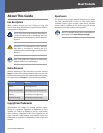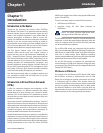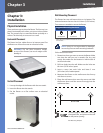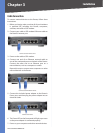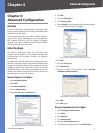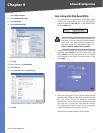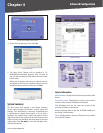
1
Introduction
4-Port SSL/IPSec VPN Router
Chapter 1
Chapter 1:
Introduction
Introduction to the Router
Thank you for choosing the Linksys 4-Port SSL/IPSec
VPN Router. The Router is an advanced Internet-sharing
network solution for your small business needs. Like any
router, it lets multiple computers in your office share an
Internet connection. It features a built-in, 4-port, full-
duplex, 10/100 Ethernet switch to connect four computers
directly, or you can connect more switches to create as
big a network as you need. If you have multiple routers in
your Local Area Network (LAN), you can use the Router’s
multiple subnet feature to support those routers.
The five Secure Sockets Layer (SSL) Virtual Private
Network (VPN) tunnels gives your mobile workers a
secure and easy way to stay connected. Additionally, an
IPSec (Internet Protocol Security), gateway-to-gateway
VPN tunnel facilitates branch office connectivity. As an
essential element of your business, the Router provides
security functions for authentication, encryption, and
firewall. Additional security features includes Denial of
Service (DoS) prevention and HTTPS management, while
the Quality of Service (QoS) features provide consistent
voice and video quality throughout your business.
Use the browser-based utility to configure settings and
run convenient wizards that will help you set up the
Router and its access rules.
Introduction to Virtual Private Networks
(VPNs)
A VPN is a connection between two endpoints—a VPN
Router, for instance—in different networks that allows
private data to be sent securely over a shared or public
network, such as the Internet. This establishes a private
network that can send data securely between these two
locations or networks.
The private network is established by creating a “tunnel”. A
VPN tunnel connects the two computers or networks and
allows data to be transmitted over the Internet as if it were
still within those networks. A VPN tunnel uses industry-
standard encryption and authentication techniques to
secure the data sent between the two networks.
Virtual Private Networking was created as a cost-effective
alternative to using a private, dedicated, leased line for a
private network. It can be used to create secure networks
linking a central office with branch offices, telecommuters,
and/or professionals on the road. The 4-Port SSL/IPSec
VPN Router supports two of the most popular VPN tunnel
types, SSL and IPSec.
There are two basic ways to create a VPN connection:
VPN Router to VPN Router
computer (using SSL VPN client software) to
VPN Router
NOTE: The 4-Port SSL/IPSec VPN Router does
not support IPSec VPN client software.
The VPN Router creates a “tunnel” or channel between two
endpoints, so that data transmissions between them are
secure. A computer with SSL or IPSec VPN client software
can be one of the two endpoints.
For an IPSec VPN tunnel, any computer with the built-in
IPSec Security Manager (Windows 2000 and XP) allows the
VPN Router to create a VPN tunnel using IPSec (Windows
Vista uses a similar utility). Other Windows operating
systems require additional, third-party VPN client software
applications that support IPSec to be installed.
For an SSL VPN tunnel, a computer can download the
Virtual Passage SSL VPN client software during first-time
connection to the SSL VPN Portal. (See “Appendix B: Virtual
Passage SSL VPN Client.”)
VPN Router to VPN Router
An example of a VPN Router-to-VPN Router VPN would
be as follows. At home, a telecommuter uses his VPN
Router for his always-on Internet connection. His Router
is configured with his office’s VPN settings. When he
connects to his office’s router, the two routers create a VPN
tunnel, encrypting and decrypting data. As VPNs utilize
the Internet, distance is not a factor. Using the VPN, the
telecommuter now has a secure connection to the central
office’s network, as if he were physically connected.
•
•




